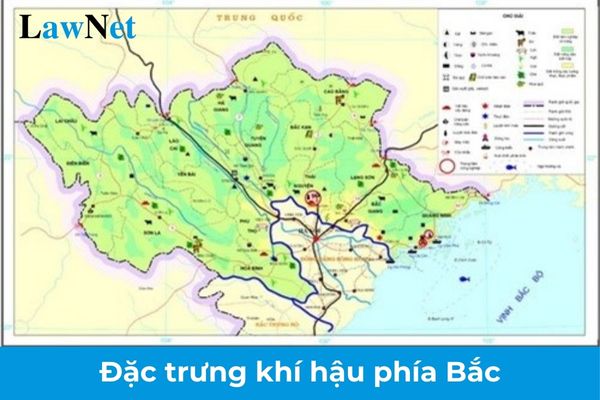What is the climate characteristic of the northern territory of Vietnam? What are the assessment levels for learning results in the whole school year of 12th-grade students in Vietnam?
What is the climate characteristic of the northern territory of Vietnam?
The northern territory of Vietnam, lying from the Bach Ma range outward, has the characteristic climate of a tropical monsoon region, with clear seasonal differentiation.
Below is a suggested answer to the question "What is the climate characteristic of the northern territory of Vietnam?":
| 1. Tropical monsoon humid climate - Tropical: Due to being within the tropical zone, the northern territory receives a large amount of solar radiation year-round, leading to high temperatures (annual average from 22 - 27°C). - Humid: Abundant rainfall, averaging 1,400 - 2,000 mm per year, with high air humidity, averaging over 80%. - Monsoon: The climate is strongly influenced by two main monsoon seasons: + Northeastern monsoon in winter (November to April), bringing cold and dry air from the Asia - Europe continent. + Southwestern monsoon in summer (May to October), carrying moisture from the sea, causing heavy rains. 2. Clear seasonal characteristics The northern territory experiences a distinctly seasonal climate with two main seasons: - Cold, dry winter (from November to April): + Influenced by the Northeastern monsoon, temperatures drop low, with severe cold spells. + Low rainfall, decreased humidity, dry weather, especially in high mountainous areas. + Average temperature is about 15 - 20°C, with some places dropping below 0°C, featuring frost or hoarfrost (such as Sa Pa, Mau Son). - Hot, humid, and rainy summer (from May to October): + Influenced by the Southwestern monsoon, bringing moisture from the sea causing heavy rains. + Average temperature from 28 - 30°C, sometimes exceeding 35°C. + This period experiences the most rainfall of the year, accounting for about 70 - 80% of the total annual precipitation. 3. Large temperature amplitude (humid subtropical climate) - Due to the influence of the Northeastern monsoon and terrain, the northern territory has large daily and seasonal temperature amplitudes. - Annual temperature amplitude: Ranges from 12 - 15°C (cold winter, hot summer). - In high mountainous areas, such as Sa Pa or Mau Son, the climate has humid subtropical characteristics at high altitudes, with cool summers and harsh winters. 4. Seasonal rainfall and uneven distribution - Rainfall is primarily concentrated in summer, while winter sees a significant reduction in precipitation. - Northern mountainous regions (such as Hoang Lien Son, Northeast) receive more rainfall compared to plains. - Extreme weather events such as heavy rains, flash floods, and landslides often occur during the rainy season in the northern mountainous areas. 5. Influence of extreme weather events - Severe cold: Commonly occurs in winter when the Northeastern monsoon is strong. - Tropical storms: The northern territory lies within the storm-affected area, mainly from June to September. - Hoarfrost and frost: Appear in high mountainous areas during winter. 6. Spatial differentiation - Plains: Typical tropical monsoon humid climate, with small temperature variations between seasons. - High mountainous regions: Climate characterized by subtropical or temperate conditions, colder winters, and higher rainfall on windward slopes. - Coastal areas: Climate strongly influenced by the sea, with high rainfall and humidity, less affected by severe cold. 7. Climate impact in the North on nature and socio-economics - For nature: + Diverse climate conditions promote the development of tropical, subtropical, and temperate ecosystems (in high mountainous areas). + High rainfall and humidity support the growth of tropical moist forests but also pose erosion and landslide risks in mountainous homestead land. - For socio-economics: + Distinct seasonal weather facilitates diverse agricultural production (rice cultivation, industrial crops, temperate fruits and vegetables in high mountainous regions). + However, extreme weather phenomena such as severe cold, storms, and floods also cause considerable damage, affecting life and production. 8. In summary: The climate of the northern territory of Vietnam is characterized by a tropical monsoon humid climate with clear seasonal differentiation, cold and dry winter, and hot, humid, rainy summer. Additionally, the climate is spatially differentiated (plains, high mountains, coastal areas) and affected by extreme weather events such as severe cold, storms, frost, and flash floods. |
Note: The content is for reference purposes only.

What is the climate characteristic of the northern territory of Vietnam? What are the assessment levels for learning results in the whole school year of 12th-grade students in Vietnam? (Image from the Internet)
What are the assessment levels for learning results in the whole school year of 12th-grade students in Vietnam?
According to Clause 2, Article 9 of Circular 22/2021/TT-BGDDT, 04 assessment levels for learning results in the whole school year of 12th-grade students in Vietnam include:
a) Excellent:
- All subjects assessed with feedback are placed in Qualified category.
- All subjects assessed by both feedback and scores have minimum scores of 6.5 for DTBmhk and DTBmcn with 6 subjects among which have minimum scores of 8.0 for DTBmhk and DTBmcn.
b) Good:
- All subjects assessed with feedback are placed in Qualified category.
- All subjects assessed by both feedback and scores have minimum scores of 5.0 for DTBmhk and DTBmcn with 6 subjects among which have minimum scores of 6.5 for DTBmhk and DTBmcn.
c) Qualified:
- Have no more than 1 subject assessed via feedback placed in Unqualified category.
- At least 6 subjects assessed by both feedback and scores have minimum scores of 5.0 for DTBmhk and DTBmcn with 0 subjects have scores lower than 3.4 for DTBmhk and DTBmcn.
d) Unqualified: Remaining cases.
How many assessment forms for the learning and training results of 12th-grade students are there in Vietnam?
Under Article 5 of Circular 22/2021/TT-BGDDT, learning and training results of 12th-grade students in Vietnam shall be assessed in two forms, including:
- Assessment via feedback
- Assessment via scores

